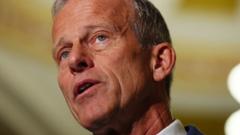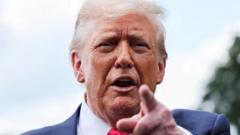During a recent NATO summit in The Hague, European allies pledged to enhance their military spending to 5% of their national income by 2035, a move applauded by President Trump, who has long demanded greater defense contributions from NATO members.
NATO's New Defense Spending Commitment Satisfies Trump

NATO's New Defense Spending Commitment Satisfies Trump
In a significant development, NATO allies agree on substantial military spending increases as a response to rising threats, gaining Trump's approval.
The NATO summit held in The Hague concluded with a landmark agreement among European allies to substantially ramp up military spending as a counter to escalating threats, particularly from Russia. President Trump, attending the summit, expressed his satisfaction with the commitment, which had been a central theme of his administration's foreign policy.
The gathered nations resolved to increase their military expenditures to 5% of national income by the year 2035. This ambitious plan outlines a baseline of 3.5% for traditional military needs—such as troops, weaponry, and munitions—markedly up from the current 2% benchmark. Furthermore, an additional 1.5% will be dedicated to “militarily adjacent” projects, which encompasses investments in infrastructure like roads and bridges, emergency healthcare enhancements, and cybersecurity improvements aimed at strengthening national resilience.
At a post-summit news conference, Trump characterized the gathering as “tremendous,” acknowledging the United States' pivotal role in European defense. He remarked, “They want to protect their country, and they need the United States." Such statements resonate with his long-standing critique of NATO allies as being overly reliant on American military support.
The summit's final communiqué reaffirmed NATO's commitment to the collective defense principles articulated in Article 5 of the NATO treaty, a commitment that Trump has historically hesitated to endorse publicly despite affirming it privately. The previous concerns regarding allies' financial contributions had fueled discussions about potential U.S. withdrawal from the alliance, further intensifying the stakes for NATO members.
This agreement marks a significant shift in NATO's funding dynamics, reflecting a response to heightened geopolitical tensions in Europe and a reinforcement of transatlantic defense cooperation.
The gathered nations resolved to increase their military expenditures to 5% of national income by the year 2035. This ambitious plan outlines a baseline of 3.5% for traditional military needs—such as troops, weaponry, and munitions—markedly up from the current 2% benchmark. Furthermore, an additional 1.5% will be dedicated to “militarily adjacent” projects, which encompasses investments in infrastructure like roads and bridges, emergency healthcare enhancements, and cybersecurity improvements aimed at strengthening national resilience.
At a post-summit news conference, Trump characterized the gathering as “tremendous,” acknowledging the United States' pivotal role in European defense. He remarked, “They want to protect their country, and they need the United States." Such statements resonate with his long-standing critique of NATO allies as being overly reliant on American military support.
The summit's final communiqué reaffirmed NATO's commitment to the collective defense principles articulated in Article 5 of the NATO treaty, a commitment that Trump has historically hesitated to endorse publicly despite affirming it privately. The previous concerns regarding allies' financial contributions had fueled discussions about potential U.S. withdrawal from the alliance, further intensifying the stakes for NATO members.
This agreement marks a significant shift in NATO's funding dynamics, reflecting a response to heightened geopolitical tensions in Europe and a reinforcement of transatlantic defense cooperation.























